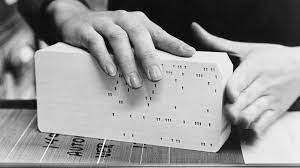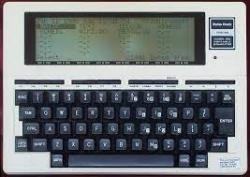 I met my first computer in 1976, in the basement of Herman Brown Hall, on the campus of Rice University in Houston.
I met my first computer in 1976, in the basement of Herman Brown Hall, on the campus of Rice University in Houston.
The computing happened in a big room, separated from me by a window. I passed a stack of punch cards, tied with a rubber band, through the window. They came back along with my output. Which usually said the program had died on Line 3.
By the time I got out of journalism school, two years later, computing was moving to desktops. A neighbor bought a $20,000 Cromemco machine that could run 3 terminals. She hired friends to work at the terminals, transcribing court records. I think they got 50 cents a page. Computing had come home.
 I got my first computer in 1982 and never looked back. For most of my life, computing has happened on a desktop. The location of that desk could move, at some sacrifice to capability. In 1989 I wrote some stories in Japan on a TRS-100, then filed them from a trade show floor to editors in America and England.
I got my first computer in 1982 and never looked back. For most of my life, computing has happened on a desktop. The location of that desk could move, at some sacrifice to capability. In 1989 I wrote some stories in Japan on a TRS-100, then filed them from a trade show floor to editors in America and England.
It wasn’t until 20 years later that this broke down. An Android or iPhone puts computing in your hand. Most of the money we put into computers today goes into phones. The best cost what my old Kaypro did 30 years ago, almost $2,000. Desktop machines can now be had for $500, and their market is circling the drain. When a market stops growing it begins to die, just like people. As I wrote a week ago, the desktop is dying.
What’s next? To me that seems obvious.
Computing is moving into the air.

The hidden revolution of our time involves computing in the air, untouched by human hands. A SpaceX rocket works because of signals traveling along wires, but also because of controls handled over radio. Factories can be this way. Hospitals can be this way. Cities can be this way.
What is delaying this is security, true. But it’s also imagination. Breaking down a system into something you can trust, but that’s still autonomous, is the main challenge. We have the sensors. We have the clouds. We have the networks. All we need are the applications.
They’re coming. In five years, maybe less, most computing will go on untouched by human hands. That doesn’t mean computing will be beyond our control. It means our reach will have expanded.









